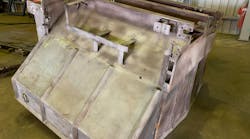Chemical processing companies face increasing scrutiny from regulators and the public over substance exposure and safety. Proper storage and handling of vessels for bulk materials is a critical factor that often gets overlooked when it comes to chemical safety. That’s unfortunate when considering the number of failures, collapses and operational problems the industry has encountered over the years with clogging, ratholing and flow stoppage.
Statistically, there have been more failures and problems in handling and storage equipment of solids and bulk materials compared to fluid handling equipment and other branches of equipment in the processing industries. Causes of failures may include flow stoppages, feed-rate/flow-control issues, particle segregation, attrition, product quality concerns, degradation, material build-up, wear, corrosion, and inadequate structural/mechanical integrity for equipment and vessels.
Among the key considerations chemical companies must evaluate are the different sizes, shapes, configurations and construction materials available for silos, bins and hoppers. Here’s a closer look at nine factors chemical processing companies should understand to ensure they’re selecting the best storage and handling option for their applications.
1. Optimize the Flow Pattern
The ideal flow pattern of solids and bulk materials is mass flow, meaning the bulk material in the vessel remains in motion whenever anything is removed from the storage container. The mass flow is the most desired flow because it is inherently safer with minimum risks and issues. Mass flow is particularly important if the application is vulnerable to operational difficulties, such as ratholing, or if there is a concern about particle degradation, such as caking, spoilage or oxidation.
For any flow regime, the particle movements in different locations vary and often the pattern of movements would be complex. Typically, particles near the center of the silo/bin see virtually no shearing resistance, whereas particles sliding along converging hopper walls flow (move) slowly. This velocity distribution (the differences of velocities of particles) can be minimized by an appropriately steep hopper angle.
For desirable mass flow, manufacturers should configure walls of the hopper sufficiently steep. Two key parameters in this regard are wall friction angle and the effective angle of internal friction. Some factors that impact these two parameters include temperature, moisture, time of solid storage at rest, particle size distribution and content of the bulk solid.
The wall friction angle plays a major role in the flow pattern. This is the arc tangent of the coefficient of sliding friction between the bulk solid and hopper wall. This value often changes with local pressure of the bulk material. To achieve mass flow throughout a hopper, it’s important to determine the wall friction angle at different locations, including the outlet.
As a rule of thumb, for wall friction angle of 10°, 15°, 20° and 25°, the conical hopper angle (from horizontal) should be larger than 58°, 61°, 65° and 71°, respectively. As a guide, the conical hopper angle (from horizontal) larger than 65° can provide mass flow regime for many practical situations. For some difficult bulk materials, this angle should be larger than 70°. In a hopper, the wall friction angle varies. Its highest value usually occurs at the lowest pressure. During the flow of bulk material, the lowest pressure is at the outlet. Therefore, the outlet region requires the steepest hopper angle for mass flow to develop.
2. Prevent Arching and Ratholing
Arching, also known as bridging or doming, is a major problem in the storage of bulk materials and solids. Causes of arching include mechanical interlocking or cohesive strength. Mechanical interlocking occurs when particles are large relative to the outlet opening, whereas cohesive arching occurs because of bonding between particles.
To avoid interlocking arching, the outlet should be wider than the largest particle. A way to estimate this is by measuring the length of a chord that spans the largest particle in any direction. In other words, the outlet dimension should exceed some critical multiple of the characteristic particle dimension. As a rough indication, for a circular or square outlet, the outlet size should be at least seven to nine times the characteristic particle dimension.
Ratholing is another major problem associated with the storage and flow of bulk materials/solids. In ratholing, a vertical flow channel develops above the hopper outlet and, once emptied, remains stable. At this point, peripheral bulk materials remain in place, so the hopper cannot be emptied. The outlet is the smallest flow channel through which the bulk material should move. Therefore, arching or ratholing nearly always occurs at the outlet. To prevent these problems, a “mass flow” pattern should be ensured, for instance, by using a sufficiently large outlet and steep walls.
3. Understand Fine Powders Vs. Coarse Solids
Fine powders behave dramatically differently than coarse bulk solids do. The discharge rates of fine powders through the outlet may be excessively high (referred to as flooding) or excessively low. Which of these extremes occurs depends to a large extent on the flow pattern in the silo or bin. Flooding often occurs in a funnel flow due to a stable rathole collapsing or the addition of fresh bulk material to a stable rathole.
Mass flow regimes, on the other hand, typically offer a controlled rate of discharge when handling fine powders. One reason is the interstitial gas or air flow through the voids. This gas or air flow is due to the small gas or air pressure gradients that develop naturally as bulk material flows through a converging hopper. Such gradients are not present with coarse materials or solids because of their much larger void space. Often, the gas or air pressure gradient at the outlet of a mass flow regime acts upward, drawing in air through the outlet. Acting counter to gravity, this retards the flow. This effect can limit rates of discharge that are several orders of magnitude smaller than the one of the free-flowing coarse bulk material having the same bulk density. In other words, for coarse bulk materials there might be a risk of uncontrolled fast discharge of materials (flooding).
4. Carefully Configure the Outlet
The outlet region of a hopper, silo or bin is an extremely important region for the smooth and trouble-free operation. It has tremendous effects in the developed flow pattern in the vessel and the type and extent of potential flow problems. As a rule of thumb, critical discharge rates vary more or less linearly with the outlet area. Typically, operators desire a sufficiently large outlet for optimal flow. However, there are practical limits on the size and configuration of the outlet due to several factors, including the size of the feeder, subsequent equipment (next equipment on the process that the bulk material is supplied to), etc.
It’s important to emphasize good configuration, weld quality and finishing in the outlet region, even while recognizing there could be practical limits and challenges for the outlet opening. The instantaneous rate of discharge is an important parameter, but considerations should also be given to the expected minimum and maximum rates.
Also, a generally symmetric/concentric shape and layout of the outlet is preferable over asymmetric, offset or eccentric outlets due to many reasons including better flow of bulk materials and fewer risks of problems. A single outlet on the centerline of the bin/silo/vessel (a concentric outlet) is ideal. While multiple outlets have been used successfully in some applications, they come with many risks such as problems of material flow and require thorough checks and maintenance, particularly if eccentric outlets are employed.
When flow problems occur, unskilled operators will often use a mallet in the outlet region to encourage flow. Unfortunately, mallet blows can distort a hopper, thereby creating even more of an impediment to flow. Obviously, the mallet blow is not a cure; formulate a proper modification or solution only after a thorough RCA (root cause analysis). Also, the outlet section should be strongly designed and fabricated with proper thicknesses and reinforcements.
5. Match the Feeder to the Outlet
In most bulk material handling applications, a feeder is used to control discharge from the outlet of the vessel. The control involves not only stopping and starting flow but also metering the rate of discharge. A feeder typically provides the ability to meter or control the throughput rate, often in flood-loaded mode.
The type of feeder to be used also influences the shape of the outlet. If the operation is using a rotary valve, the hopper outlet should usually be either circular or square. On the other hand, if the facility is using a belt or screw feeder, the outlet is often elongated. With an elongated outlet, the interface details become extremely important to ensure the outlet area is fully active.
Several hopper configurations are possible in this scenario. Perhaps the most common is a transition hopper. Another hopper configuration compatible with an elongated outlet is a chisel hopper. A wedge-shaped hopper also can be used with elongated outlets, although as with pyramidal hoppers, there are some concerns with valley angles and inflowing valleys. Ideally, for bulk materials, which are prone to flow problems, it’s best to avoid elongated or unusually shaped outlets and, instead, opt for large, circular outlets.
In addition to arching, ratholing and flow-rate considerations, it’s important to carefully consider the size of the feeder in the overall design of the vessel. Most commercial feeders come in standard dimensions. For this reason, it may be necessary to increase the outlet size to match the next-larger feeder size above the one required by the design/operational considerations.
A small feeder operating at too high a speed may not be efficient or may be subject to unacceptable abrasive wear or cause excessive particle attrition. Enlarging the feeder to reduce its speed is often the correct selection.
6. Carefully Consider Aeration
Operators can significantly increase the discharge rate of fine powders by using low levels of aeration. There are several different aeration techniques. One technique is to use an air permeation system, which consists of a sloping shelf or insert that allows a small amount of air to be added to a silo or bin. This air permeates into the bulk solid and lessens the need for air to be drawn in through the outlet. The careful and uniform distribution of air is necessary to maximize its effectiveness, limit the air flow rate and pressure to avoid fluidization.
Aeration can be a solution for overcoming poor silo or bin designs versus more expensive modifications as any modifications usually need re-design, cutting, welding, etc. However, some operators consider aeration to be risky. Use it only as a last resort when other options, such as steep walls for the hopper are not practical.
7. Segregation and Sifting
Segregation is a common problem in storage and handling of bulk materials and solids, resulting in unacceptable quality variations and safety concerns. Segregation typically occurs by one of three common mechanisms: sifting, dusting and fluidization.
Sifting involves the movement of smaller particles through a matrix of larger ones. Dusting (particle entrainment) occurs when small or light particles are carried by air currents within a vessel, resulting in a segregation profile that is difficult to predict and to avoid.
Fluidization (air entrainment) occurs when larger or denser particles settle through a fluidized matrix of finer (or lighter) particles. The result is a top-to-bottom segregation pattern that is difficult to overcome.
8. Fabrication and Site Installation Considerations
Generally, if the bin or silo is not too large, it can be shop fabricated in one piece, and welded equipment is preferable. It can then be lifted into place with a crane. A challenge for large bins and silos, which should be fabricated in two or a few subassemblies and delivered in pieces to the site, is the selection of field welds or bolt connections.
For larger vessels that should be field welded, alternative bolted construction is often preferable, although stress concentrations of bolted joints tend to weaken the entire structure. Furthermore, the possibility of leakage exists even if gaskets are used. It’s usually better to assemble and disassemble very large bins and silos using bolt connections. On the other hand, subassemblies should be as large as possible to minimize the number of bolt connections.
Construction material is another important consideration. Many large silos and bulk material storage units are made from reinforcement concrete. The advantage here is that reinforced concrete can overcome abrasion or corrosion concerns common with metals. A double layer of reinforced steel will likely be required, especially if the silo or bin has multiple outlets or any type of asymmetry in loads applied to the vessel walls.
9. Pick a Liner
Usually, some form of liner or coating is required in bins, hoppers and silos, particularly for abrasive applications. One of the main reasons for using a liner or coating is to achieve a low-wall friction angle. As a result, less-steep hopper angles are required for the mass flow. Liners or coatings also can provide abrasive wear or impact resistance as well as chemical or corrosion resistance.
Whatever liner or coating is chosen, it’s important to consider the ability to repair or replace it as such a liner/coating might be damaged or worn out after some years of operation. Differential thermal expansion and contraction between the vessel and liner should be considered carefully. Different thermal movements always mean stresses and risk of damage or cracking.



